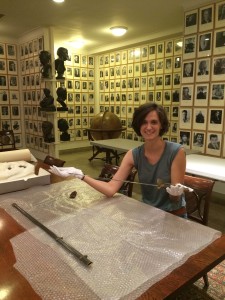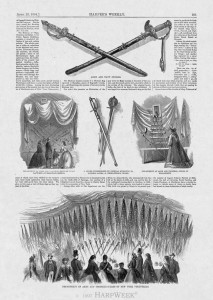Civil War Era Swords
EMERGING SCHOLARS > SUMMER RESEARCH GRANTS
by Ruthie Dibble
Yale University, History of Art, PhD. Candidate
Thanks to the generosity of the Decorative Arts Trust, this summer I conducted crucial fieldwork relating to my dissertation, “’Strike Home to the Minds of Men: Crafting Domesticity in the Civil War Era.” This project scrutinizes the various attempts to redefine the meaning of domesticity during the Civil War and Reconstruction periods. I am examining how destabilized households and dramatically shifting gender roles found their way into a range of material culture—paintings, photography, architecture, decorative arts, and the dwellings Southerners and Northerners inhabited.
My summer research centered on my first dissertation chapter, which examines presentation swords and their relationship to wartime constructions of chivalry in the North and the South. The tradition of sword presentation is steeped in chivalrous romance used by both home fronts to cast the war as a defense of the home rather than an act of political aggression. I aimed to study some of the era’s most aesthetically and culturally significant swords as well as visit archives with materials relating to the production of swords in the 1860s.
I conducted research at the Tiffany Archives in Parsippany, NJ, focusing on Tiffany & Co.’s most celebrated silversmith, Edward C. Moore, and the French-born silversmith Eugene J. Soligny. These heralded artisans produced many of the most innovative and ornate presentation swords of the 19th century. A trove of their drawings for hilts modeled after allegorical figures provided valuable insight into the development of a design for which Tiffany & Co. became renowned. A particularly fascinating series of drawings suggests that Moore drew inspiration from Thomas Crawford’s statue Freedom, which was placed on the dome of the United States capitol in 1863, at the height of the Civil War.
My third stop was the National Museum of American History, where I was able to handle one of the most important collections of presentation swords, including a Tiffany & Co. blade exhibited at the Metropolitan Sanitary Fair in 1864 that was later presented to Ulysses S. Grant. This sword, which incorporates the head from Crawford’s Freedom, attracted the public’s attention during the fair. Thousands of women voted to determine the sword’s recipient, constituting an unprecedentedly public, and publicized, act of female suffrage.
As any lover of decorative arts can attest, nothing equals the thrill of a full sensory experience with such beautiful and storied objects. I am so grateful to the Decorative Arts Trust for making this work possible.
SAVE THE DATE
- Special Symposium
“Classical Splendor”
The Philadelphia Museum of Art
November 4, 2016 - New York Antiques Weekend
January 20-21, 2017 - Spring Symposium
Savannah
April 21-24, 2017 - Spring Study Trip Abroad
Scotland
May 14-22, 2017 - Fall Symposium
Hartford & Western Connecticut
September 2017 - Fall Study Trip Abroad
Venice and the Veneto
October 9-16 and 22-29, 2017
by Ruthie Dibble
Yale University, History of Art, PhD. Candidate
Thanks to the generosity of the Decorative Arts Trust, this summer I conducted crucial fieldwork relating to my dissertation, “’Strike Home to the Minds of Men: Crafting Domesticity in the Civil War Era.” This project scrutinizes the various attempts to redefine the meaning of domesticity during the Civil War and Reconstruction periods. I am examining how destabilized households and dramatically shifting gender roles found their way into a range of material culture—paintings, photography, architecture, decorative arts, and the dwellings Southerners and Northerners inhabited.
My summer research centered on my first dissertation chapter, which examines presentation swords and their relationship to wartime constructions of chivalry in the North and the South. The tradition of sword presentation is steeped in chivalrous romance used by both home fronts to cast the war as a defense of the home rather than an act of political aggression. I aimed to study some of the era’s most aesthetically and culturally significant swords as well as visit archives with materials relating to the production of swords in the 1860s.
I conducted research at the Tiffany Archives in Parsippany, NJ, focusing on Tiffany & Co.’s most celebrated silversmith, Edward C. Moore, and the French-born silversmith Eugene J. Soligny. These heralded artisans produced many of the most innovative and ornate presentation swords of the 19th century. A trove of their drawings for hilts modeled after allegorical figures provided valuable insight into the development of a design for which Tiffany & Co. became renowned. A particularly fascinating series of drawings suggests that Moore drew inspiration from Thomas Crawford’s statue Freedom, which was placed on the dome of the United States capitol in 1863, at the height of the Civil War.
My third stop was the National Museum of American History, where I was able to handle one of the most important collections of presentation swords, including a Tiffany & Co. blade exhibited at the Metropolitan Sanitary Fair in 1864 that was later presented to Ulysses S. Grant. This sword, which incorporates the head from Crawford’s Freedom, attracted the public’s attention during the fair. Thousands of women voted to determine the sword’s recipient, constituting an unprecedentedly public, and publicized, act of female suffrage.
As any lover of decorative arts can attest, nothing equals the thrill of a full sensory experience with such beautiful and storied objects. I am so grateful to the Decorative Arts Trust for making this work possible.


